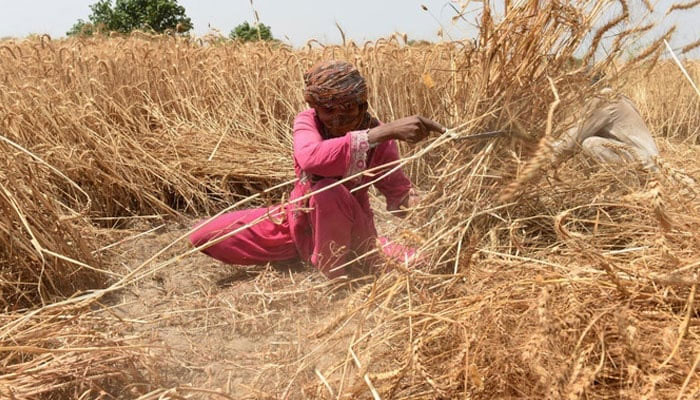Country to face 30pc water shortage in early Kharif, 7pc in late Kharif
During early Kharif from April 1 to June 10, there will be no water available for below Kotri water releases which are essential to stop the sea intrusion into Sindh’s agricultural land
ISLAMABAD: Amid reservations from the lower riparian federating unit of Sindh on water system losses and opposition to the existing three-tier formula for water distribution and Wapda’s failure to do away with Tarbela and Mangla Dams’ constraints, the IRSA Advisory Committee (IAC) that met here on Tuesday worked out 30 per cent shortage in the early Kharif season and 7 per cent in late Kharif.
The 30 per cent water shortage in early Kharif may aggravate if Wapda fails to erase constraints in the Tarbela Dam; it will certainly affect cash crops of cotton and seedlings of rice in Sindh. “During early Kharif from April 1 to June 10, there will be no water available for below Kotri water releases which are essential to stop the sea intrusion into Sindh’s agricultural land. Nearly 3.5 million acres of agricultural land in Sindh has already been eroded since 1956 during the sea intrusion because of non-availability of below Kotri water releases,” a top official of the provincial Irrigation Department told The News.
The IRSA Advisory Committee (IAC) met here to approve the Kharif 2024-anticipated Water Availability Criteria from April to September 2024 under the chairmanship of Abdul Hameed Mengal, chairman IRSA. IRSA’s five members, secretaries of provincial Irrigation Departments of the four provinces, Wapda’s water member and top officials of the Pakistan Metrological Department attended the meeting.
Sindh agitated, the official said, on this very issue and asked for the implementation of Water Accord 1991 and its para-2 for 4-5 MAF (million acres feet) water more, but in the meeting, the IRSA said that this issue was pending with the CCI (Council of Common Interests). This is why the three-tier formula was currently functional for water distribution among the provinces. Sindh strongly opposed water distribution under the three-tier formula.
Encompassing all the water availability parameters, the country is likely to have 99.41 MAF of water during the whole Kharif season. However, the country will have 23.55 MAF in early Kharif and 75.85 MAF in late Kharif from June 11 to the end of September. In canals, Punjab will have 31.13 MAF of water, Sindh 28.81 MAF followed by Balochistan with its share of 2.85 MAF and KP is to have 0.28 MAF in its canals.
During the stormy session, Sindh and Punjab blamed each other for maximum water losses in their respective territories. Sindh said water losses would be hovering around 40 per cent, but Punjab said the losses would be 20 per cent. However, the IRSA Advisory Committee decided that system losses should be considered at 20 per cent till the joint discharge measurement and then it will be decided accordingly.
As far as issues with regard to Wapda failure to complete its tunnel projects T3, T4 and T5 at the Tarbela Dam and refurbishment of power units at the Mangla Dam, Sindh lambasted Wapda for delay in completing the projects, which will affect its cash crops of cotton and rice.
Punjab also showed dismay over this issue. However, it was unanimously decided to constitute a committee comprising Member IRSA (Punjab) & Member IRSA (Sindh) along with nominated chief engineers from the PID (Power Irrigation Department) Punjab and PID Sindh to physically review and monitor the sites of both the dams and furnish a report for resolution of the operational constraints.
In the meeting, the Member (Power) Wapda assured that all irrigation indents would be fulfilled during Kharif 2024. It was agreed that the provinces of Punjab & Sindh would activate their respective Discharge Observation Cells (DOCs) for data reporting at different locations. Punjab SDOs will be stationed at Guddu, Sukkur & Kotri Barrages in Sindh, while Sindh SDOs will monitor the discharges at Jinnah H/W, Chashma Barrage, Taunsa H/W & Panjnad H/W in Punjab.
-
 Kendall Jenner Tells 'truth' About Whether She Has Had Plastic Surgery
Kendall Jenner Tells 'truth' About Whether She Has Had Plastic Surgery -
 Chris Pratt Reveals Odd Gift Arnold Schwarzenegger Gave Him And Wife Katherine
Chris Pratt Reveals Odd Gift Arnold Schwarzenegger Gave Him And Wife Katherine -
 King Charles Views Kate Middleton As 'great Asset' For Royal Family
King Charles Views Kate Middleton As 'great Asset' For Royal Family -
 Britney Spears Shares Bombshell Reason About Dancing On Social Media
Britney Spears Shares Bombshell Reason About Dancing On Social Media -
 A Red Pixel In The Snow: How AI Helped To Crack The Mystery Of A Missing Mountaineer
A Red Pixel In The Snow: How AI Helped To Crack The Mystery Of A Missing Mountaineer -
 Denise Richards, Aaron Phypers’ Divorce Takes Dark Turn: 'Not Flush With Cash'
Denise Richards, Aaron Phypers’ Divorce Takes Dark Turn: 'Not Flush With Cash' -
 How To Survive Snowstorm: Essentials Preps, Travel Guide, Driving Tips Explained
How To Survive Snowstorm: Essentials Preps, Travel Guide, Driving Tips Explained -
 Ariana Grande Awaits Ethan Slater Proposal Amid Baby Fever?
Ariana Grande Awaits Ethan Slater Proposal Amid Baby Fever? -
 Grok Restricts AI Tools To Paid Users After Deepfakes Of Women And Children Sparks Outrage
Grok Restricts AI Tools To Paid Users After Deepfakes Of Women And Children Sparks Outrage -
 Billy Bob Thornton's Marriage To Connie Angland Faces Trouble Due To Angelina Jolie
Billy Bob Thornton's Marriage To Connie Angland Faces Trouble Due To Angelina Jolie -
 Apple CEO Tim Cook Reportedly Plans To Step Down
Apple CEO Tim Cook Reportedly Plans To Step Down -
 Orlando Bloom Must 'up His Game' Amid Sofia Vergara Romance Rumours
Orlando Bloom Must 'up His Game' Amid Sofia Vergara Romance Rumours -
 Meghan Trainor's Husband Daryl Sabara Responds To Ashley Tisdale's Mom Group Comments
Meghan Trainor's Husband Daryl Sabara Responds To Ashley Tisdale's Mom Group Comments -
 Gunnar, Matt Nelson Ready To 'set The Record Straight' On Their Dad Ricky's Tragic Death
Gunnar, Matt Nelson Ready To 'set The Record Straight' On Their Dad Ricky's Tragic Death -
 Palace Insiders Warn King Charles Ahead Of Prince Harry's UK Trip
Palace Insiders Warn King Charles Ahead Of Prince Harry's UK Trip -
 February Full Moon 2026: Snow Moon Date, Time And Visibility
February Full Moon 2026: Snow Moon Date, Time And Visibility




